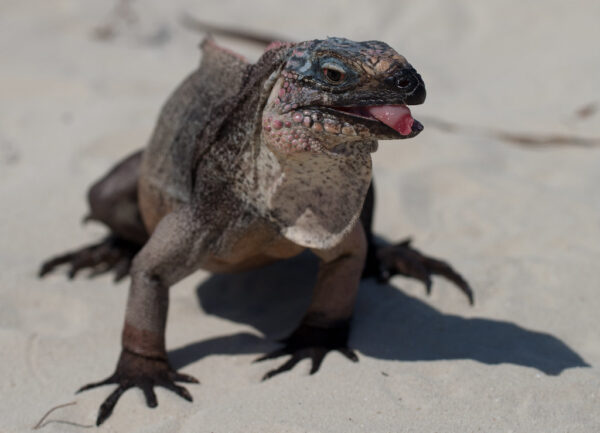Bahamian rock iguanas are a species of lizard found on Andros Island and the Exuma islands in the Bahamas. They belong to the genus Cyclura, which includes three species with seven subspecies. The scientific name for Bahamian rock iguanas is Cyclura cychlura.
Physical Traits
Bahamian rock iguanas are large lizards, typically measuring two feet in length from head to tail, though they can grow up to four feet long. They have thick body, short legs, and long tail that helps them balance while climbing trees. Their coloration varies depending on their environment, ranging from grayish-brown to green or yellow.
Life Span
The average life span of a Bahamian rock iguana is about 20 years in the wild. They can live up to 30 years in captivity with proper care and nutrition.
Habitat
Bahamian rock iguanas inhabit dry coastal areas and rocky outcrops near the shoreline of Andros Island and the Exuma islands in the Bahamas. They prefer areas with plenty of vegetation for shelter and food sources, such as cacti, shrubs, and trees. They also use termite mounds as nesting sites to lay their eggs during the breeding season.
Diet
Bahamian rock iguanas are omnivorous animals that feed on both plants and insects. Their diet consists mainly of fruits, vegetables, flowers, leaves, and small invertebrates such as beetles, crickets, and spiders. They also eat carrion when available.
Reproduction
During the breeding season (usually between April and June), female Bahamian rock iguanas will lay clutches of up to 15 eggs in termite mounds or other sheltered areas near their habitat. The eggs take about 90 days to hatch, and the young lizards mature at around two years old.
Conservation Status
The Bahamian rock iguana is listed as an endangered species due to its naturally small island populations, which are vulnerable to threats such as habitat destruction, predation by invasive species such as cats and dogs, the illegal pet trade, and climate change-related events like hurricanes or drought conditions that can reduce food sources or cause flooding of nesting sites. Organizations such as Shedd Aquarium’s Wild Reef program have put conservation efforts into place, which work towards protecting these lizards from extinction through research projects focused on understanding their behaviors better to develop conservation strategies for them in the future.
Interesting Facts
- The Bahamian Rock Iguana is one of only two lizard species native to The Bahamas, the other being the curly-tailed lizard (Leiocephalus carinatus).
- These lizards are excellent swimmers who often dive underwater for food or shelter from predators!
- The Bahamian Rock Iguana has been known to live up to 30 years in captivity with proper care!


